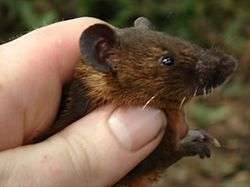Brush-furred mouse
| Brush-furred mice Temporal range: Recent | |
|---|---|
 | |
| Lophuromys sikapusi | |
| Scientific classification | |
| Kingdom: | Animalia |
| Phylum: | Chordata |
| Class: | Mammalia |
| Order: | Rodentia |
| Superfamily: | Muroidea |
| Family: | Muridae |
| Subfamily: | Deomyinae |
| Genus: | Lophuromys Peters, 1874 |
| Species | |
|
Lophuromys luteogaster | |
The brush-furred mice, genus Lophuromys are a group of rodents found in sub-Saharan Africa. They are members of the subfamily Deomyinae, a group only identifiable through molecular analysis. Lophuromys is also known as the brush-furred rats, harsh-furred rats or coarse-haired mice.
Characteristics
The brush-furred mice are so named due to the unique, stiff hairs that make up their pelage. The texture is similar to a soft brush. They are peculiar looking for several reasons. The coat varies depending on species but range from tan to greenish greys and dark brown. Some species have an almost purplish tint to the pelage and others can be speckled. The underside is rusty, orange, brown, or cream colored. They are chunky mice with relatively short legs.
Most animals have noticeable scars, notched ears, or are missing part of their tails. The skin is delicate and the animals appear to use this as a predator avoidance technique. The tail breaks easily and may be lost so that the animal can escape. Once lost, it does not regenerate. The skin tears easily, particularly in strategic positions such as the scruff of the neck. In fact, if an animal is held by the scruff of the neck, it is capable of struggling its way free by tearing itself loose leaving behind a patch of skin containing hair and epidermis. Specimens found in museums are rarely seen that lack tears that have been sewn together.
Habitat and diet
Brush-furred mice appear to require moist areas and perhaps grasses. They are generally excluded from dry savannahs and forests with dense canopies. They are variable in degree of diurnality versus nocturnality.
They appear to feed more on animal matter than most muroids. The proportion of animal material in the diet ranges from 40-100% depending on species (Dieterlan, 1976 in Nowak, 1999). Food consists of ants, other insects, other invertebrates, small vertebrates, carrion, and plant matter.
Behaviour
Brush-furred mice are solitary and are reported to fight when placed together. This may contribute to the wounds found on individuals. A brush-furred mouse was recorded to have lived for over 3 years in captivity.
Allopatric speciation appears to have played an important role in shaping the evolution of this genus. Research conducted on the group suggests that isolated species exist a relatively short distance away from one another. Gene flow is either absent or greatly restricted among these isolated pockets. This has led to differences detectable by karyotype, allozymes, and DNA sequencing. The number of recognized species in this genus has increased in recent years and is probably still not representative of the true diversity of this group.
Species
Genus Lophuromys - brush-furred mice
- Subgenus Kivumys
- Yellow-bellied brush-furred rat, Lophuromys luteogaster
- Medium-tailed brush-furred rat, Lophuromys medicaudatus
- Woosnam's brush-furred rat, Lophuromys woosnami
- Subgenus Lophuromys
- Angolan brush-furred mouse, Lophuromys angolensis
- Ansorge's brush-furred mouse, Lophuromys ansorgei
- Gray brush-furred rat, Lophuromys aquilus
- Short-tailed brush-furred rat, Lophuromys brevicaudus
- Brown brush-furred mouse, Lophuromys brunneus
- Ethiopian forest brush-furred rat, Lophuromys chrysopus
- Dieterlen's brush-furred mouse, Lophuromys dieterleni
- Dudu's brush-furred mouse, Lophuromys dudui
- Eisentraut's brush-furred rat, Lophuromys eisentrauti
- Yellow-spotted brush-furred rat, Lophuromys flavopunctatus
- Hutterer's brush-furred mouse, Lophuromys huttereri
- Black-clawed brush-furred rat, Lophuromys melanonyx
- Fire-bellied brush-furred rat, Lophuromys nudicaudus
- Rahm's brush-furred rat, Lophuromys rahmi
- Mount Cameroon brush-furred rat, Lophuromys roseveari
- Rusty-bellied brush-furred rat, Lophuromys sikapusi
- Verhagen's brush-furred mouse, Lophuromys verhageni
- Zena's brush-furred rat, Lophuromys zena
References
- Dieterlen, F. 1976. Die afrikanische Muridengattung Lophuromys Peters, 1874. Stuttgarter Beitr. Naturkunde, ser A, no 285.
- Andrew Duff and Ann Lawson (2004). Mammals of the World: A checklist. A & C Black. ISBN 071366021X.
- Kingdon, J. 1997. The Kingdon Field Guide to African Mammals. Academic Press Limited, London.
- Nowak, Ronald M. 1999. Walker's Mammals of the World, 6th edition. Johns Hopkins University Press, 1936 pp. ISBN 0-8018-5789-9